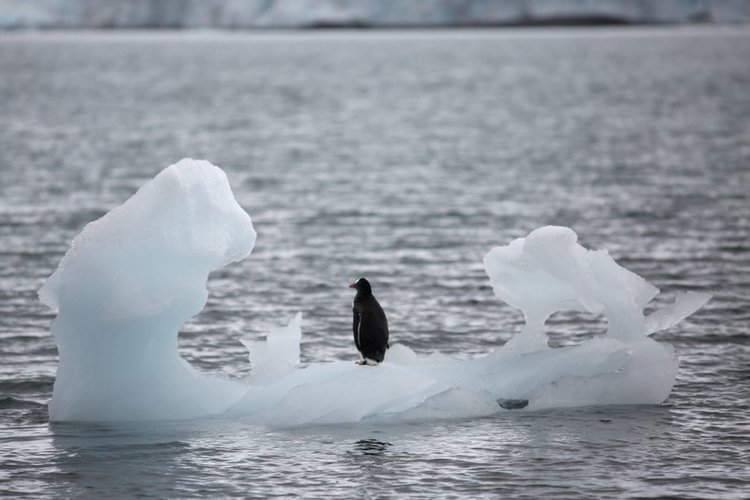Hari Sreenivasan: Antarctica, a continent of snow and ice, is now losing ice three times faster than it was in 2007. In a new study published last week in the journal Nature, more than 80 scientists from multiple countries used satellite data to examine the Antarctic's vast ice sheets. And their prediction is that if the current rate of ice melt continues, sea levels could rise six inches by the year 2100. Joining us now for more on this study and the consequences of sea level rise is Benjamin Strauss, the president and C.E.O. of Climate Central, an independent organization of scientists and journalists that research and report on the changing climate. So, first of all, this is a steady drumbeat. We've heard about sea level rise for years. How consequential, how significant is this particular study and what did it look at?
Benjamin Strauss: So the first thing I'd like to point out is Antarctica is just one part of the story. So we have six inches of contribution from Antarctica if it continues to shed ice at the rate it was measured but there are other sources as well so that altogether we would be looking at three feet.
Hari Sreenivasan: Three feet of sea level rise by the year 2100. That is consequential to hundreds of millions of people that live on coastal cities all over the planet?
Benjamin Strauss: Yes, it is. We're already seeing floods increase. Yesterday, for example, there were floods at at least eight tide gauges around the United States. Almost all of which wouldn't have happened without the sea level rise that we've already seen.
Hari Srinivasan: What is it that is convincing these scientists that the rates are changing? What are they studying? What are they looking at? How can they tell?
Benjamin Strauss: Yeah, they have a lot of direct measurements from satellites of the height of the surface of the ice sheets so they're able to see how that height changes over time. There are also amazing satellites which, in fact, measure the gravitational pull of the ice sheet and, therefore, how much ice is there. So those are the two main forms of measurement.

Hari Srinivasan: There are climate science deniers who say look at the east side of Antarctica, it looks on a map there's actually more ice coming in, doesn't this all balance itself out?
Benjamin Strauss: We do anticipate that in the future, snowfall will increase in east Antarctica and I hope so but this study shows over recent decades it hasn't. In fact, we've seen a drop in snowfall.
Hari Sreenivasan: If you take a look at some of the maps you have on your own site and you take a city like Miami, that we're all familiar that's a coastal city, and you ratchet up the scale to three feet more water. You see huge parts of what we consider to be the city of Miami under water.
Benjamin Strauss: Yeah. That's right. South Florida is severely at risk, particularly because their bedrock is porous, so even if you built levees or protective walls, water would push underneath and come up through the ground. So there are really high stakes here.
Hari Srinivasan: Even up here in the northeast, much closer to New York City, Newark, the areas around on the coastal waterway are severely impacted.
Benjamin Strauss: Yeah. A lot of airports nationwide in coastal cities are built on marshland, very...a place that's low and flat and unobstructed and away from other buildings. A lot of the them already have levees around the edges and three feet is difficult but manageable in most places. May not be manageable in south Florida. If on the other hand we continue to see the ice speeding up, we don't cut back on our climate pollution emissions, then we're pointed more towards six feet possibly and that will be unmanageable in very many places.
Hari Srinivasan: Also, the effects that we're seeing of sea level rise, of climate change in a global capacity, this is because of the carbon that we've already put into the atmosphere, not just exactly what we're doing today. So even if everyone stopped driving, all the factories shut down and somehow we didn't produce CO2, we're still going to see the effects of climate change.
Benjamin Strauss: Yes, we are. Unfortunately, once the carbon is in the atmosphere, most of it stays for hundreds and thousands of years. I think for most people, you imagine we have this problem. If it ever gets really bad that it's hurting us, drastically, we'll simply stop. We'll fix it in a few years. But the carbon keeps on insulating the earth, heating the earth more for hundreds and thousands of years. I'd say that, at a minimum, we have five more feet of sea level rise baked in and probably a good deal more if we control our pollution now, we can really slow it down a lot and make it more manageable. And that's the name of the game. Slower change will be much more manageable than the fast change. That is possible.
Hari Srinivasan: All right, Ben Strauss of Climate Central. Thanks so much.
Benjamin Strauss: Thank you.












